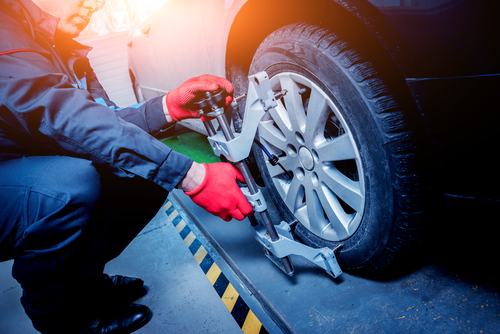Wheel Balancer
Wheel Balancing vs Wheel Aligning: The Differences
In the world of automotive care, the health of a vehicle’s wheels is crucial for ensuring a smooth and safe driving experience. Two key services in this domain are wheel balancing and wheel aligning, which, despite their importance, often cause confusion among car owners. This blog post aims to demystify these procedures, clarifying their distinct purposes and importance for optimal vehicle performance.
Understanding Wheel Balancing
Wheel balancing is essential for ensuring that your vehicle’s tyres and wheels spin smoothly without causing undue vibrations. This process becomes crucial as unbalanced wheels can significantly diminish tyre life, by as much as 50%, and even increase fuel consumption by around 10%. When wheels are not properly balanced, the uneven distribution of weight can lead to a bumpy, uncomfortable ride, and can also put additional strain on the vehicle’s suspension and steering components. The balancing process typically involves meticulously attaching small weights to the rim, which counterbalance any weight inconsistencies. This precise adjustment ensures that the wheel rotates evenly, mitigating any potential vibrations that could arise from imbalances.
Signs Your Wheels Need Balancing
Identifying the need for wheel balancing can be straightforward if you know what to look for:
- Vibrations at Different Speeds: One of the most telltale signs is experiencing vibrations, particularly noticeable at speeds between 50 and 70 mph. This discomfort can significantly impact the driving experience.
- Uneven tyre Wear: Unbalanced wheels often cause tyres to wear unevenly, which not only shortens their lifespan but can also lead to a decrease in vehicle safety. tyres on unbalanced wheels can wear out up to twice as fast as those on balanced wheels.
- Steering Wheel Vibrations: If the steering wheel shakes, especially when driving on highways, it’s a strong indicator that your wheels might be unbalanced. This can not only be annoying but also distracting while driving.
Regular wheel balancing is not just about comfort; it’s about longevity and efficiency. Properly balanced wheels can extend tyre life by up to 20%, ensuring a smoother ride and minimising tyre wear, which is vital for both safety and economy.
The Importance of Wheel Aligning
Wheel aligning, also known as vehicle alignment, is another critical aspect of vehicle maintenance. Misaligned wheels can lead to a staggering 70% reduction in tyre life and a 10% increase in fuel consumption. This process involves adjusting the angles of the vehicle’s wheels to ensure they are set to the specifications recommended by the manufacturer. Proper alignment is crucial for straight driving, efficient fuel consumption, and even tyre wear. Misaligned wheels can cause the vehicle to pull to one side, leading to not only an annoying driving experience but also increased strain on the car’s overall mechanics. The alignment process typically involves fine-tuning the vehicle’s suspension system, ensuring that the wheels are perfectly aligned for optimal performance.
Indicators of Misaligned Wheels
Knowing when to get your wheels aligned is key to maintaining your vehicle’s health:
- Vehicle Pulling to One Side: A car that drifts or pulls to one side while you’re attempting to drive straight is a clear sign of misalignment. This not only affects the vehicle’s handling but can also be a safety concern.
- Uneven tyre Wear Patterns: When your wheels are misaligned, it often results in uneven wear on your tyres. This can lead to the need for premature tyre replacement, which is both costly and inconvenient.
- Steering Wheel Off-Center: If you notice that the steering wheel is off-center when driving straight, it’s a strong indication that your wheels are misaligned. This misalignment can affect the overall driving experience and may lead to safety issues.
Addressing wheel misalignment is not just about avoiding inconvenience; it’s crucial for safety and economy. Proper alignment can improve mileage by up to 10% and significantly extend tyre life, making it a worthwhile investment for any vehicle owner.
Comparing the Processes: Balancing vs. Aligning
While both wheel balancing and aligning are essential for proper vehicle maintenance, they serve different purposes and address different issues. Wheel balancing is primarily concerned with the distribution of weight around the wheel to prevent vibrations, while wheel aligning ensures that the vehicle’s wheels are aligned correctly for straight driving and even tyre wear. Balancing ensures a smooth ride and minimises tyre wear, whereas aligning is essential for proper vehicle handling and maximising tyre lifespan. It’s important to understand when each service is needed and to ensure that both are performed regularly.
Ensuring a Smooth Journey: The Essential Duo of Wheel Care with AAQ
Both wheel balancing and wheel aligning are vital aspects of tyre maintenance, each playing a crucial role in ensuring optimal vehicle performance. Ignoring these procedures can lead to increased tyre wear, reduced fuel efficiency, and compromised safety. Regular check-ups and maintenance are key to prolonging the life of your tyres and ensuring the overall health of your vehicle. A balanced and aligned vehicle is not only a happy vehicle but also a safe and efficient one, ensuring a smooth journey every time. For personalised professional wheel care advice today, get in touch with the experts at AAQ today.

